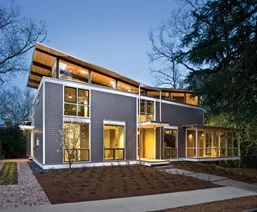From vinyl siding to composite siding, there are a very large number of exterior cladding options on the market. And there is not always a single choice. You may want to use cladding to highlight a certain part of your building. Or you may prefer a variety of matching designs. We know how to combine textures and materials to achieve beautiful cladding designs. Read on for the design ideas we offer to inspire you! Whatever style you’re trying to achieve, cladding has you covered.
What is cladding?
Cladding is the protective and decorative outermost layer applied to the exterior of a building. You can think of it as a building’s coat. It protects the home from the cold, wind and rain and gives the building a beautiful look. Common cladding materials are wood, metal, vinyl, or composite. they all offer a variety of styles and textures to enhance the look and durability.
Black timber cladding with faux stone
Traditional wood cladding can achieve a perfect match with faux stone. Combine black wood siding with natural wood cladding. Timber near the midpoint of the house can add a touch of warmth to the building, catching the eye. And highlights the sharp lines and eclectic architectural style. Placing faux stone near the entrance can add a touch of texture and contrast to the design.
White cladding
Warm white cladding colors of natural materials are ideal for modern architecture. Using the same cream color on the exterior brickwork and cladding provides some interesting textural contrast using a mix of materials. We retained the existing stone wall cladding of the house and complemented it with timber porch posts to create a warm inviting look.
Slatted facade
Another popular cladding option is the slatted facade. Slatted facades are able to rotate the orientation of individual panels so that the cladding creates a vertical design. Commonly found in coastal areas, slatted facades can give an authentic look to homes of all architectural styles.
The traditional cladding installation process is very labor intensive. Modern fiber cement cladding simplifies the installation process. It utilizes a simple clip-in cladding system. This speeds up the installation process and minimizes potential installation errors.
Earth Colors
Earthy colors are popular in both residential and commercial designs. Contemporary materials using earth tones can recreate a variety of textures and styles in one durable product.
Fiber cement stone exterior cladding with built-in moisture barrier. It can be combined with smooth architectural panels or wood cladding made from the same material. This way, you can mix and match earth-toned facades without having to worry about the compatibility of different cladding products. Whether you want a brick, stucco or wood look, fiber cement tile exterior cladding makes the process simple and seamless. Whether you want a brick, stucco or wood look, fiber cement tile exterior cladding makes the process simple and seamless.
Mix and Match Colors
Consider mixing and matching multiple color palettes. With modern composite cladding products, you can mix and match colors, textures, orientations and styles as you please. Fiber cement cladding is designed to be easily matched, so you can combine a brick style façade with colored slats or wood grain overlays fairly easily.
Concrete Cladding
The smooth look of concrete cladding can draw attention to itself as a more aesthetically pleasing option. Concrete style facades can achieve a unique look for a building, although concrete can deteriorate and crack. Cracks in the concrete can become a major issue down the road, both in terms of structural integrity and aesthetics.
Traditional timber cladding
Wood cladding can showcase natural wood grain patterns and can add a more traditional aesthetic to your building. However, wood can suffer from dry rot, moisture damage, or mold, and requires regular care and maintenance by the homeowner. Regular sanding and staining can make wood cladding more durable and maintain its appeal year after year. Wood cladding is more suitable for both residential and commercial properties.
Bright Colors
Brightly colored exteriors are becoming more popular in commercial establishments because it looks more unique. Any brightly colored facade needs to be consistent, so it’s vital to choose a durable, long-lasting exterior cladding material that can resist fading caused by sunlight.
For more information click here.









